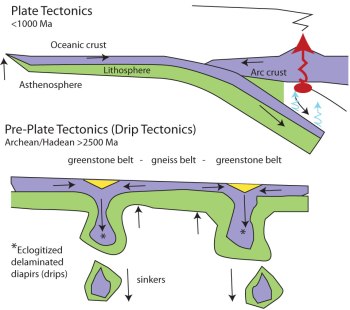Formation of continents without subduction
The formulation of the theory of plate tectonics provided plausible explanations for the growth of continental crust over time, among many other fundamental Earth processes. Briefly expressed, once basalt capped oceanic lithosphere is forced downwards at plate boundaries where plates move towards one another, beyond a certain penetration cool, moist basalt undergoes a pressure-controlled change of state. Its chemical constituents reassemble into minerals more stable under elevated pressure. In doing so, one outcome involves dehydration reactions the other being that the bulk composition is recast mainly in the form of high-pressure pyroxene and the mineral garnet: the rock eclogite. The density of the basaltic cap increases above that of the mantle. Gravity acts to pull the subducting slab downwards, this slab-pull force being the main driver of plate motions globally. Water vapour and other fluids shed by dehydration reactions rise from the subducted slab into the wedge of overlying mantle to change its conditions of partial melting and the composition of the magma so produced. This is the source of arc magmatism that persists at the destructive plate margin to increase the volcanic pile's thickness over time. When magma is able to pond at the base of the new crust its fractional crystallisation produces dense cumulates of high-temperature mafic silicates and residual melt that is both lighter and more enriched in silica. Residual magma rises to add to the middle and upper crust while the cumulate-rich lower crust becomes less gravitationally stable, eventually to spall downwards by delamination. Such a process helps to explain the bulk low density of continental crust built up over time together with the freeboard of continents relative to the ocean floor: a unique feature of the Earth compared with all other bodies in the Solar System. It also accounts for the vast bulk of continental crust having remained at the surface since it formed: it rarely gets subducted, if at all.

One suggested model for pre-plate tectonic continent formation (credit, Robert J Stern https://speakingofgeoscience.org/2013/04/28/when-did-plate-tectonics-begin-on-earth-and-what-came-before/)
Tangible signs that such subduction was taking place in the past – eclogites and other high-pressure, low-temperature metamorphosed basalts or blueschists – are only found after 800 Ma ago. Before that time evidence for plate tectonics is circumstantial. Some geologists have argued for a different style of subduction in earlier times, plates under riding others at low angles. Others have argued for a totally different style of tectonics in Earth early history, marked by changes in bulk chemical composition of the continental crust at the Archaean-Proterozoic boundary. A new twist comes from evidence in the Archaean Pilbara Craton of Western Australia (Johnson, T.E. et al. 2017. Earth's first stable continents did not form by subduction. Nature, v. 543, p. 239-242; doi:10.1038/nature21383). The authors found that basalts dated at about 3.5 Ga have trace-element geochemistry with affinities to the primitive basalts of island arcs. That makes them a plausible source for slightly younger felsic plutonic rocks with a tonalite-trondhjemite-granodiorite (TTG) compositional range (characteristic of Archaean continental crust). If the basalts were partially melted to yield 30% of their mass as new magma the melt composition would match that of the TTG crust. This would be feasible at only 30 km depth given a temperature increase with depth of at least 25° C per kilometre; more than the average continent geothermal gradient today but quite plausible with the then higher heat production by less decayed radioactive isotopes of uranium, thorium and potassium 3.5 Ga ago. This would have required the basalts to have formed a 30 km thick crust. However, the basalts' geochemistry requires their generation by partial melting of earlier more mafic basalts rather than directly from the mantle. That early Archaean mantle melting probably did generate vast amounts such primary magma is generally acknowledged and confirmed by the common occurrence of komatiitic lavas with much higher magnesium content than common basalts of modern constructive margins. In essence, Johnson et al. favour thermal reworking of primitive Archaean crust, rather than reworking in a plate tectonic cycle.
More on continental growth and plate tectonics
See also
When did Plate Tectonics begin on Earth, and what came before?
--
Posted by: Lin Kerns <linkerns@gmail.com>
No comments:
Post a Comment